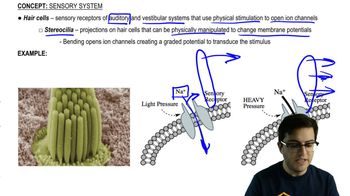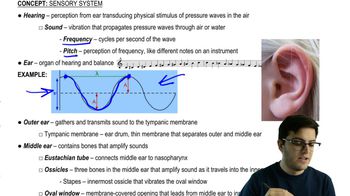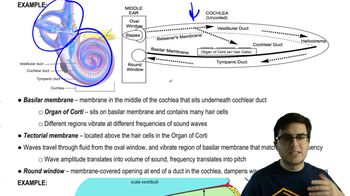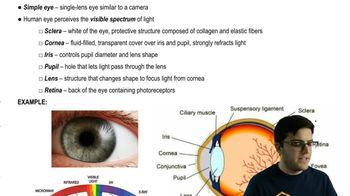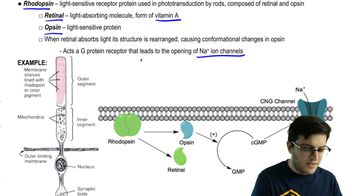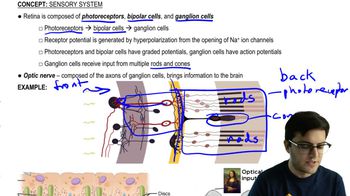Table of contents
- 1. Introduction to Biology2h 42m
- 2. Chemistry3h 40m
- 3. Water1h 26m
- 4. Biomolecules2h 23m
- 5. Cell Components2h 26m
- 6. The Membrane2h 31m
- 7. Energy and Metabolism2h 0m
- 8. Respiration2h 40m
- 9. Photosynthesis2h 49m
- 10. Cell Signaling59m
- 11. Cell Division2h 47m
- 12. Meiosis2h 0m
- 13. Mendelian Genetics4h 44m
- Introduction to Mendel's Experiments7m
- Genotype vs. Phenotype17m
- Punnett Squares13m
- Mendel's Experiments26m
- Mendel's Laws18m
- Monohybrid Crosses19m
- Test Crosses14m
- Dihybrid Crosses20m
- Punnett Square Probability26m
- Incomplete Dominance vs. Codominance20m
- Epistasis7m
- Non-Mendelian Genetics12m
- Pedigrees6m
- Autosomal Inheritance21m
- Sex-Linked Inheritance43m
- X-Inactivation9m
- 14. DNA Synthesis2h 27m
- 15. Gene Expression3h 20m
- 16. Regulation of Expression3h 31m
- Introduction to Regulation of Gene Expression13m
- Prokaryotic Gene Regulation via Operons27m
- The Lac Operon21m
- Glucose's Impact on Lac Operon25m
- The Trp Operon20m
- Review of the Lac Operon & Trp Operon11m
- Introduction to Eukaryotic Gene Regulation9m
- Eukaryotic Chromatin Modifications16m
- Eukaryotic Transcriptional Control22m
- Eukaryotic Post-Transcriptional Regulation28m
- Eukaryotic Post-Translational Regulation13m
- 17. Viruses37m
- 18. Biotechnology2h 58m
- 19. Genomics17m
- 20. Development1h 5m
- 21. Evolution3h 1m
- 22. Evolution of Populations3h 52m
- 23. Speciation1h 37m
- 24. History of Life on Earth2h 6m
- 25. Phylogeny2h 31m
- 26. Prokaryotes4h 59m
- 27. Protists1h 12m
- 28. Plants1h 22m
- 29. Fungi36m
- 30. Overview of Animals34m
- 31. Invertebrates1h 2m
- 32. Vertebrates50m
- 33. Plant Anatomy1h 3m
- 34. Vascular Plant Transport1h 2m
- 35. Soil37m
- 36. Plant Reproduction47m
- 37. Plant Sensation and Response1h 9m
- 38. Animal Form and Function1h 19m
- 39. Digestive System1h 10m
- 40. Circulatory System1h 57m
- 41. Immune System1h 12m
- 42. Osmoregulation and Excretion50m
- 43. Endocrine System1h 4m
- 44. Animal Reproduction1h 2m
- 45. Nervous System1h 55m
- 46. Sensory Systems46m
- 47. Muscle Systems23m
- 48. Ecology3h 11m
- Introduction to Ecology20m
- Biogeography14m
- Earth's Climate Patterns50m
- Introduction to Terrestrial Biomes10m
- Terrestrial Biomes: Near Equator13m
- Terrestrial Biomes: Temperate Regions10m
- Terrestrial Biomes: Northern Regions15m
- Introduction to Aquatic Biomes27m
- Freshwater Aquatic Biomes14m
- Marine Aquatic Biomes13m
- 49. Animal Behavior28m
- 50. Population Ecology3h 41m
- Introduction to Population Ecology28m
- Population Sampling Methods23m
- Life History12m
- Population Demography17m
- Factors Limiting Population Growth14m
- Introduction to Population Growth Models22m
- Linear Population Growth6m
- Exponential Population Growth29m
- Logistic Population Growth32m
- r/K Selection10m
- The Human Population22m
- 51. Community Ecology2h 46m
- Introduction to Community Ecology2m
- Introduction to Community Interactions9m
- Community Interactions: Competition (-/-)38m
- Community Interactions: Exploitation (+/-)23m
- Community Interactions: Mutualism (+/+) & Commensalism (+/0)9m
- Community Structure35m
- Community Dynamics26m
- Geographic Impact on Communities21m
- 52. Ecosystems2h 36m
- 53. Conservation Biology24m
46. Sensory Systems
Sensory System
Problem 11a`
Textbook Question
Honeybees live in social groups consisting of a queen, up to several hundred male drones, and thousands of infertile female workers. The drones mate with the queen only, and the workers protect the hive, forage, and feed and groom the queen. The health of the hive depends on the female workers performing these duties instead of reproducing.
What roles do pheromones play in maintaining a functional beehive?
Scientists have identified dozens of pheromones used by honeybees for communication. Which type of sensory system uses pheromones?
a. Mechanoreception
b. Photoreception
c. Chemoreception
d. Thermoreception
e. Electroreception
 Verified step by step guidance
Verified step by step guidance1
Understand the role of pheromones: Pheromones are chemical signals released by an organism to affect the behavior or physiology of other members of the same species. In honeybees, pheromones are crucial for communication and maintaining social structure within the hive.
Identify the function of pheromones in a beehive: In the context of a beehive, pheromones help regulate the activities of the queen, drones, and worker bees. They can signal the presence of the queen, suppress the reproductive capabilities of worker bees, and coordinate foraging and defense activities.
Determine the sensory system involved: Pheromones are detected through a sensory system that can perceive chemical signals. This system is responsible for processing the chemical cues that pheromones provide.
Review the options for sensory systems: The options given are mechanoreception (sensing mechanical changes), photoreception (sensing light), chemoreception (sensing chemicals), thermoreception (sensing temperature), and electroreception (sensing electrical fields).
Select the correct sensory system: Since pheromones are chemical signals, the sensory system that detects them is chemoreception. Therefore, the correct answer is c. chemoreception.
 Verified video answer for a similar problem:
Verified video answer for a similar problem:This video solution was recommended by our tutors as helpful for the problem above
Video duration:
1mPlay a video:
Was this helpful?
Key Concepts
Here are the essential concepts you must grasp in order to answer the question correctly.
Pheromones
Pheromones are chemical substances produced and released into the environment by animals, affecting the behavior or physiology of others of the same species. In honeybees, pheromones are crucial for communication within the hive, influencing roles such as mating, foraging, and maintaining social order. The queen releases specific pheromones to inhibit worker reproduction and ensure hive cohesion.
Recommended video:
Guided course
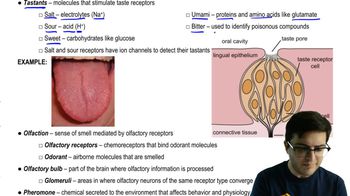
Smell and Taste
Chemoreception
Chemoreception is the sensory system that detects chemical stimuli, allowing organisms to perceive pheromones. In honeybees, chemoreceptors located on their antennae detect pheromones, facilitating communication and coordination within the hive. This system is essential for interpreting chemical signals that regulate social behaviors and hive functions.
Recommended video:
Guided course

Smell and Taste
Social Structure of Honeybees
The social structure of honeybees is characterized by a division of labor among the queen, drones, and worker bees. The queen is responsible for reproduction, drones for mating, and workers for maintaining the hive. This structure relies on pheromonal communication to ensure that each group performs its specific roles, contributing to the overall health and efficiency of the hive.
Recommended video:
Guided course

Community Structure
Related Videos
Related Practice






